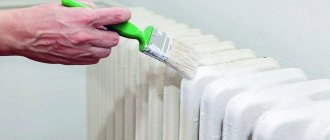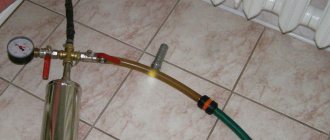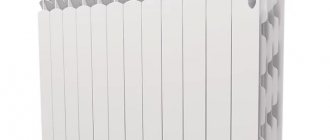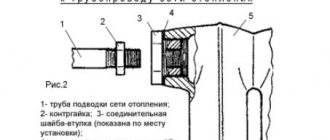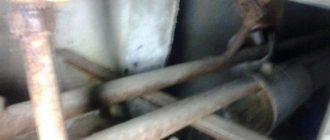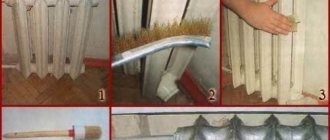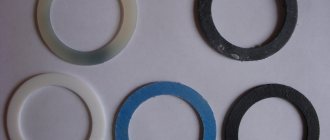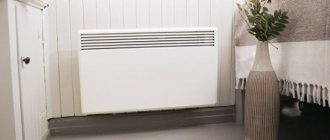Reasons and need for cleaning
Why is it necessary to make efforts to clean heating devices? Like any objects in a residential area, heating radiators become dirty, not only from the outside, but also from the inside. Dust accumulates on the surface of appliances, which can negatively affect the well-being of residents. In addition to dust, such devices often have greasy contaminants that are difficult to remove.
It is necessary to thoroughly rinse heating batteries if:
- the battery heats up unevenly - one part differs in temperature from the other even to the touch;
- the apartment warm-up time has increased compared to previous seasons;
- radiators are cooler than the thermal mains;
- For residents of private houses, a characteristic sign of the need for flushing is the fact of an increase in energy resources for heating, provided that heat transfer is reduced or maintained at the same level.
Contamination of heating batteries occurs due to changes in the quality of the liquid. This fact contributes to the settling of mechanical particles moving together with the coolant. After the end of the season, the water is drained, and corrosion often begins to develop inside the pipe. When the heating season resumes, under the pressure of hot water, corrosive particles begin to move and settle in the radiator. Over time, debris builds up, which can lead to blockages and poor performance. Thus, lack of cleaning can lead to a decrease in the heat output of the batteries while maintaining the same costs.
The main signs of the need for flushing
Flushing radiators is necessary when the efficiency of the heating system decreases.
There are several signs of the accumulation of a large number of foreign elements inside the radiator and the formation of scale on the walls. This can be diagnosed by carefully monitoring the operation of the entire heating system.
If the system is faulty, the following symptoms will appear:
- the system warms up for a longer period of time than before;
- the operation of the boiler is accompanied by strange sounds;
- gas or electricity consumption increases;
- the temperature differs in different parts of the radiator;
- radiators are cooler than supply pipes.
Most often, radiator cleaning is necessary when the battery is connected to a centralized heating system. This is due to the long length of the highway and the large number of connected equipment.
Basic methods
There are many ways to remove dust from a battery. You do not need to purchase any special tools; most devices are publicly available. Cleaning can be done using electrical appliances, improvised means, with or without the use of chemicals.
Electrical appliances
Thorough cleaning of the battery can be done using electrical appliances. It is important to take precautions.
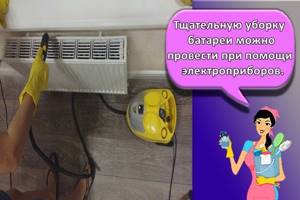
Vacuum cleaner
You can use a vacuum cleaner for cleaning. It is advisable to use a narrow nozzle, this will allow you to penetrate hard-to-reach places. First you need to remove all dust and debris from the inside, then treat the outside. When finished, you can wipe the radiator with a damp cloth.
To use a hair dryer, you must first place a towel or any thick cloth soaked in water under the radiator. Direct a stream of hot air onto the radiator. The dust will move from the battery to the damp cloth. Not the most effective way: dirt can remain between the sections, get into the air or walls, floor.
Steam generator
A steam generator will do an excellent job of removing contamination (especially accordion-type radiators). To clean, you will need to direct a stream of hot steam to the radiator. Such heat treatment will not only effectively remove even old dirt, but will also disinfect the surface. Under pressure, steam penetrates into narrow, hard-to-reach parts. To protect surrounding surfaces from exposure to steam, you can cover them with cloth or oilcloth. It is also important to know that the high temperature of the steam can negatively affect the coating: damage the paint.
Washing vacuum cleaner
A good alternative to a regular vacuum cleaner. It will cope perfectly even with serious dirt. Cleaning should begin from the inside, and then proceed to the outer surface. A washing vacuum cleaner, thanks to an aqua filter, can prevent the spread of dust throughout the room.
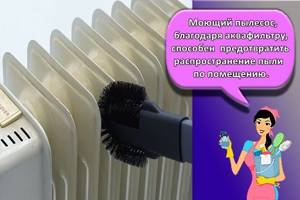
Available means
You can thoroughly clean the inside of the battery from dust using improvised means that are found in every home. The most popular means are presented below.
Spray
Before using a spray bottle or country sprayer, it is necessary to place a basin or any container under the battery where the water will drain. Dissolve a few drops of any detergent in the liquid and spray the contaminated areas. Hold for a few minutes. Wipe with a clean cloth.
Brushes for painting windows
Small brushes that will certainly be able to penetrate between the sections and remove dirt from hard-to-reach places. You can use a device for painting radiators, which has an elongated handle and curved bristles. A regular tassel can also be extended using a stick and electrical tape.
Toothbrush
The main difficulty in high-quality cleaning of heating appliances is inaccessibility. A toothbrush will perfectly remove dirt in hard-to-reach conditions. You can soak the bristles in detergent and wrap them with a cloth for more thorough cleaning.
Boiling water
You must first place some kind of container under the battery, for example, a baking tray or a basin, to avoid contamination of surrounding surfaces. Pour water previously brought to a boil onto the top of the battery, not forgetting the side parts. Water and dust will fall into the prepared container. In the same way, you can clean out internal contaminants.
Outside
How to rinse cast iron radiators, as well as all others? You can clean up the outside of the radiator using several methods - it all depends on the degree of contamination.
Dry cleansing
Everything we cover here is more suitable for everyday cleaning. For general purposes, more serious methods are needed. So, there are two simple and effective ways:
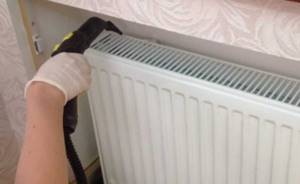
- Using a vacuum cleaner. It’s very good if you have special attachments - because the battery sections are sometimes very close to each other, so you can’t get to them with a regular floor brush.
- Using a hair dryer. In this case, a damp cloth of suitable size is attached between the wall and the radiator. Air from the device simply blows dust between the battery sections onto this cloth. Then it remains to carefully remove the material and rinse it from dust.
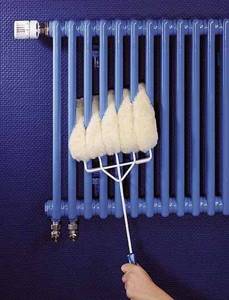
Wet cleansing
How to clean a heating battery when it is very dirty? If you want to do high-quality spring cleaning, then this is the place for you. First of all, we focus on the degree of contamination of the radiator:
Light to medium soiling. Before wet cleaning, it is best to carry out dry cleaning, which we described above. It is advisable to use hot water, even boiling water. Be sure to find a container of suitable size that can be placed under the entire duration of the battery - water will flow into it
Then, from another container, carefully pour boiling water over the battery, section by section. After the water has drained from it, it is additionally dried with prepared rags, napkins

Washing areas between sections. To ensure that wet cleaning reaches areas between sections that we physically cannot reach with our hands, it is best to use a steam mop (pictured). Some housewives additionally spread cotton napkins for better steam absorption. As an option, you can wrap a rag around a pointer, a stick, a narrow handle, or a nozzle for something and, moistening it in water, clean hard-to-reach areas.
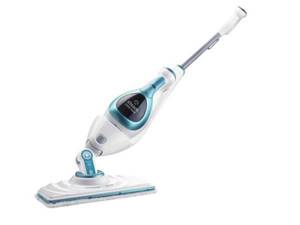
Heavy contamination. Anti-fat agents are used. An aqueous solution is first prepared from them, which is poured into a spray bottle or spray bottle and thoroughly sprayed over a moistened battery. Then some time is given to “acidify”. After which the cleaning solution is completely removed with water and rags from the surface of the battery.
Chemical and traditional methods
To increase cleaning efficiency, detergents can be added to the water. Before use, you must make sure that the composition does not contain substances contraindicated for treating specific surfaces. Some substances can damage the metal surface. We should not forget about the harmfulness of some components to the human body, for example, phosphate and chlorine. When working with such substances, it is important to use respiratory and skin protection.
Hydrogen peroxide
A good helper in the household is 3% hydrogen peroxide. This well-known substance perfectly cleans and disinfects batteries. To use, add ¾ of a bottle to 2-3 liters of water. To remove severe stains, you can use pure peroxide by applying the substance directly to the stained area or with a sponge.
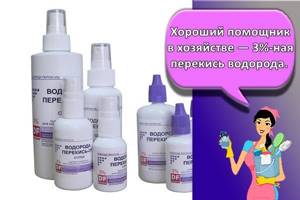
Lemon acid
Using citric acid, you can not only effectively clean the radiator from contamination, but also get rid of the unpleasant odor. As a rule, the smell appears from stagnant water and flower fertilizer that has reached the surface of the radiator. To prepare a cleaning solution, you will need to dissolve 3 tsp in a glass of water. citric acid.
Baking soda
Regular baking soda is suitable for cleaning the battery. To do this, dissolve 2 tbsp in 3 liters of water. l. soda For greater effect, you can add 1 tsp. apple cider vinegar and 7 drops of any liquid soap.
Vinegar 9%
Vinegar is poured into a spray bottle for further spraying onto the stained area, previously cleaned with a damp cloth. Afterwards, the battery must be thoroughly rinsed with water and wiped. Vinegar essence mixed with water in a ratio of 1:10 can also be used. When spraying in the room, the windows should be open; it is better to protect the respiratory tract with a mask.
Use of special compounds
Effortlessly, in just a few minutes, special cleaning products will help remove dirt and grease stains. To remove greasy stains, you can use dishwashing detergents, for example, Fairy, Pemolux, MYTH. Before use, it is necessary to dilute the concentrate in water, foam it and wipe the surfaces of the radiator with a brush or sponge. Light stains can be removed with laundry soap. Complex contaminants can be removed using special household chemicals intended for plumbing fixtures and household appliances, for example, Domestos, Krot, Tiret. Old stains are removed using stain removers, for example, “Vanish” and “Antipyatin”.
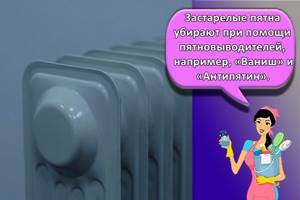
General cleaning of radiators
General cleaning should be carried out in every corner of the house. Radiators cannot be ignored either. In order for the cleaning to be complete, it is necessary to first remove the liquid from the heating system and dismantle the radiator. The radiator should be washed using household or specialized cleaning products. Cleaning can be done at home, in the bathroom.
To avoid damage to the enamel of the bathroom, it is necessary to lay a cloth on the bottom and install a mesh in the drain hole to avoid the penetration of large pieces of debris into the sewer.
Remove all plugs from cast iron batteries and fill the insides with hot water. During the first flushing, it is recommended to shake the radiator and drain the water and debris. For further washings, special detergents can be added to the water. It is better to leave the radiator with a mixture of water and household chemicals for an hour. Flushing is carried out until the water becomes clear, free of debris, dirt, and rust.
Do-it-yourself washing
In order to rinse heating radiators (aluminum and cast iron) yourself, without involving dangerous chemicals and complex devices, the radiators will have to be dismantled.
Sequencing:
- Preparing tools and space. For the procedure you will need the following tools: a set of keys, paint, sealing tow, a large container. During dismantling, the contents of the batteries will most likely spill, so you need to cover the floor with plastic film and additionally lay a rag on it. It is also necessary to move nearby furniture, remove curtains and, if possible, cover the walls. In an apartment, the bathroom will be used, so you should take care of the covering and tiles. In the bath itself, you should put a wooden tray and a mesh over the drain into the sewer.
- Dismantling. When removing the radiator, turn off the coolant supply tap or drain the water from the system. Next, unscrew the radiator and drain the remaining water into a prepared container. Now the battery can be moved to the bathroom.
- Flushing. For convenience, you should unscrew the plugs and shut-off valves. Next, we pass a stream of hot water under pressure through the radiator. If there is a lot of dirt and water does not help, you can use a solution of soda ash, vinegar, citric acid, car radiator cleaners or other available acid-base compounds. To do this, you need to return the plugs to their place and pour in the cleaning solution for a couple of hours. While the reagent is active, it is recommended to tap the radiator to enhance the reaction. Then rinse thoroughly with water and repeat the procedure if necessary.
- Return to place. It is necessary to wipe the radiator, seal the plugs with tow and paint. Learn how to install heating batteries in an apartment yourself using the link.
Features of cleaning aluminum products
Aluminum is a metal that reacts well with any elements. This leads to rapid oxidation of aluminum radiators. The consequences of such processes are rapid contamination of heating systems, which can lead to failure of the radiator. Therefore, aluminum structures must be thoroughly cleaned and their condition regularly monitored. Cleaning methods are similar to those listed above - you can use high pressure water, special chemicals, professional equipment, and improvised materials. It is important to remember that aluminum reacts poorly to alkalis, but positively to acids. This fact should be taken into account when choosing a cleaning product.
Centralized cleaning or individual
Residents of apartment buildings can clean the heating system individually and centrally. Utilities provide such services using primarily hydropneumatic technology. But for this, the procedure must be agreed upon with the neighbors, and certain material costs will also be required. Centralized flushing may take some time. For owners of private houses, only individual cleaning is possible.
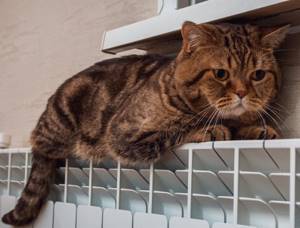
Rules of care and use
Regular cleaning of all elements will help preserve heating batteries for a long time. The radiator should be cleaned once per heating season, and the outer surface of the battery should be wiped regularly. It is recommended to do wet cleaning of surfaces every time you clean a room, because dust actively accumulates between the walls of the radiator, gets eaten, and actively spreads throughout the room, causing allergic reactions. When choosing a radiator cleaner, you should carefully read the instructions, apply the necessary precautions, and select the active substance based on the material of the product.
How to manually remove old paint from a battery
Cast iron radiators, due to their long service life, are periodically tinted. The high temperature with which the material is constantly in contact forces the coating to warp and all this takes on an unpresentable appearance.
There are several ways to quickly get rid of the old protective layer on cast iron:
- A paint remover such as white spirit will do the job. But you will have to sweat, washing everything or making lotions with this substance. The drug has a strong, unpleasant odor, so the procedure must be performed with the windows open.
- Sandblasting is not difficult if you have a special device, which is rare. Just stick the nozzle into the radiator, and it will do everything itself.
- Construction hair dryer - refers to thermal methods and can damage the rubber seals between the segments.
- A brush attachment on a drill is not the easiest method of mechanical cleaning, but it is effective. The main thing is not to overdo it, otherwise you can damage the cast iron.
To avoid having to clean radiators frequently, you need to choose a special heat-resistant paint.
Once you know how to clean your battery inside and out, you should be patient and take time before organizing an event. In both cases, the process is lengthy and sometimes dangerous. Especially if cleaning is carried out during the heating season. When you have doubts about your own abilities, it is better to seek help from a plumber.
Signs of internal contamination of cast iron batteries
At the end of the heating season, the water from the heating radiator system is drained, and throughout the entire period when it is turned off, the radiators remain dry from the inside, and with the arrival of the new season they are filled with water. This alternation inevitably leads to corrosion of the metal from which the radiators are made. Their insides become covered with rust, and the poor quality and hardness of the water in them leads to the formation of limescale. You can determine that internal battery cleaning is necessary by the following signs:
- During the heating season, you may notice that one of the sections or the entire radiator is colder than the rest of the radiators in the house. This is a clear sign that the inside of this area is covered with a thick layer of rust or plaque;
- if the temperature of the riser is higher than that of the battery, this is another obvious sign that hot water does not enter the radiator in full due to internal contamination;
- all the radiators in the apartment are slightly warm, while those of the neighbors in the house are hot;
- uneven heating of the battery also indicates that cleaning is necessary.
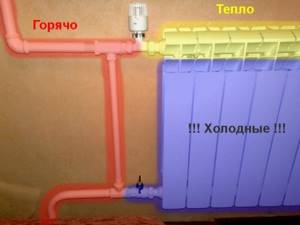
Even if such signs have not been noted, it is recommended to carry out preventive cleaning before the start of each heating season. You can entrust this to the heating network workers or do it yourself.
How to disassemble a cast iron radiator
The joints of the old battery are quite strong. In many cases, they “grow together” in such a way that strength alone is not enough. Therefore, before disassembling the battery, it should be placed on boards and properly prepared.
The simplest preparation involves heating the joint. To do this, use a hair dryer or a blowtorch. The latter can burn old paint. However, it's not scary.
More serious preparation involves heating the metal to such an extent that it begins to glow. After this they try to unscrew the nipple. This can be done both when the alloy becomes very hot, and when it has cooled noticeably. The second option is even better, because during cooling the gasket becomes covered with cracks and the strength of the connection becomes weak. He is often shown in videos.
To disassemble a battery made of cast iron, you need to perform the following steps:
- Unscrew the plugs (plugs).
- Place the radiator key on top of the device so that the flattened end rests on the nipple. Make a mark on the key where the battery ends using chalk or electrical tape.
- Insert the key inside the bottom hole.
- Turning it along the axis to the right and left, insert it into the product up to the drawn mark.
- Determine which way the nipple is screwed. To do this, bait it with the right and left sides. If you manage to bait it with the right side, then you need to unscrew it counterclockwise.
- If you manage to move the nipple, then make one revolution. Next, a similar procedure is done with the nipple at the other end of the section.
- Both nipple nuts are unscrewed in turn. Otherwise the section will crack.
- In the same way, you need to unscrew all sections.
If it was not possible to disassemble the heating battery in this way, you will have to saw through the section that is leaking. At the same time, they saw it in the center of the nipple. The work is carried out by picking up a grinder or a hacksaw.
Another option is to break the bad section with a sledgehammer. You need to break the middle part of the section. The nipple, which remains unharmed, is unscrewed using a plumbing wrench. It can also be knocked out using a hammer and chisel. Then you need to clean the threads in entire sections.
Preparing to clean the batteries internally
Washing batteries yourself at home requires some preparation:
- Most often, washing occurs in the bathroom. To protect the enamel coating from possible scratches, you should place a tray on the bottom of the bathtub or cover it with a rag; it is also better to cover the walls with a layer of unnecessary fabric. Otherwise, there is a risk of damaging the bathtub coating when washing part of the radiator in it.
- Then you should turn off the water supply valves, unscrew the fastening nuts, and disconnect the radiator. It is worth preparing a container in advance into which the water will be drained (it may remain in the battery).
- Prepare the means at hand that you will use for cleaning.
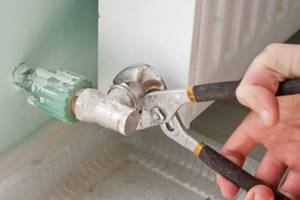
Battery cleaning products
Before flushing the radiator, you should prepare in advance the following tools and items that may be needed during the process:
- cleaning products for cleaning pipes from contamination, such as “Mole” and its analogues;
- citric or acetic acid;
- wooden hammer (optional);
- spray;
- pipe cleaners, old toothbrushes, foam sponges.
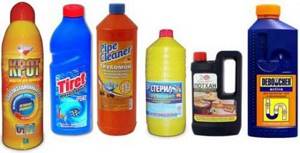
Flushing radiators in particularly advanced cases
In some cases, if the blockage is severe, it is necessary to completely dismantle the heating radiators and pour chemical compounds into the radiator cavity for several hours.
In extreme cases, it is possible to disassemble the radiators into separate sections and then wash them with chemical compounds. The radiator is installed in the reverse order. Just keep in mind that this method can only be performed with certain skills: not everyone can assemble a radiator from individual sections on their own; in this case, a specialist is required.
Sometimes it's easier to just buy new radiators.
If you wash your heating radiators regularly, they will last a long time, and your apartment or private house will always be warm and cozy.
Share
- 4
home order, repairs
The process of cleaning radiators from the inside
If everything is ready, you can begin the process of flushing the battery.
- By tapping each section with a wooden hammer, you can speed up the peeling off of thick rust and lime deposits. Large particles of clog that fall off after this can simply be shaken out.
- Regular hot water is poured into the section tanks without any additional cleaning agents. It needs to be left there for half an hour and then drained.
- During the next flushing step, a cleaning solution is poured into the battery. There may be several options. The most popular due to its low cost is water with vinegar essence or citric acid dissolved in it. However, higher efficiency is observed with special, industrially produced products for clearing blockages in pipes. They should be used according to the attached instructions. If acetic or citric acid was used, the holding time should be one hour. The cleaning solution is then drained from the battery.
- The next stage of flushing the radiator is to remove any remaining contaminants soaked from the chemical cleaning solution. Water should be poured into the radiator from a shower or hose under pressure until the liquid that flows out is absolutely clean. Accumulations of dust in hard-to-reach places can be removed manually using brushes, a brush, or a foam sponge placed on the end of a ruler.
Such washing should be carried out at least once every three years. This will ensure high-quality heating of the living space. Clean radiators do not retain heat, heat up normally and effectively heat the apartment.
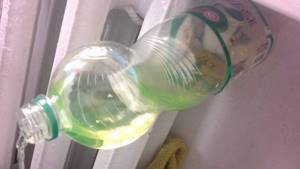
Cleaning batteries using special equipment
Cleaning cast iron batteries without removing them can be done using special equipment. The following complex equipment is intended for domestic needs:
- pneumatic pistol "Typhoon";
- device for electrohydropulse influence ZEVS-24;
- cleaning device Krot-Mini.
Pneumatic pistol "Typhoon"
Air pistol "Typhoon"
Flushing the battery with a Typhoon pneumatic gun
The equipment is compact and easy to use. It is used to perform targeted impact on blockages in water and sewer pipes with a diameter of up to 150 mm. The essence of the process is a hydraulic ram to remove hardened deposits from the walls of equipment and adjacent risers with a shock wave at a speed of 1.5 km/h, which spreads over a distance of up to 60 meters.
Pneumatic pistol "Typhoon" in action
This cleaning of the heating system allows you to completely remove contaminants that are not amenable to conventional hydraulic flushing.
"Typhoon" is indispensable as a plumber's tool for clearing blockages in various hard-to-reach places. Depending on the configuration and weight, the device has 6 modifications and the following indicators:
- internal cleaning diameter up to 150 mm;
- maximum firing range to the target is 60 m;
- special valve design for kinetic ramming;
- pressure gauge on the body;
- Possibility of manual inflation.
Comprehensive flushing of heating batteries
As a rule, “Typhoon” is used in conjunction with the ZEVS-24 automatic installation and the Krot-Mini device for cleaning hard-to-reach objects.
Installation ZEUS-24
ZEUS-24 has small dimensions and sufficient power to destroy hardened heating devices, internal and external water supply and sewerage networks that are firmly stuck to the inner walls. The essence of its work is based on the electrohydropulse effect on solid contaminants in pipes with a diameter of 7 to 150 mm. The electrical discharge created by the device leads to the generation of a shock wave and powerful hydrodynamic flows that act on hardened clogs, scale and deposits.
Procedure for hydropneumatic flushing of heating radiators (batteries)
Advantages of the device:
- destruction of blockages of any strength;
- safety of the equipment being cleaned;
- cleaning of hard-to-reach bent and spiral pipes;
- wear resistance of manufacturing materials;
- protective shutdown on the plug.
Krot-Mini device
The unit is used for cleaning pipes with a diameter of 20 to 150 mm. It is compact, has sufficient power, is affordable and is indispensable for cleaning in-house sewer networks and other pipelines. The design is easy to use; the spiral in the drum makes it possible to clean any hard-to-reach places. The device is intended for a wide range of consumers: from homeowners to housing and communal services, hotels, gas stations, and industrial enterprises.
